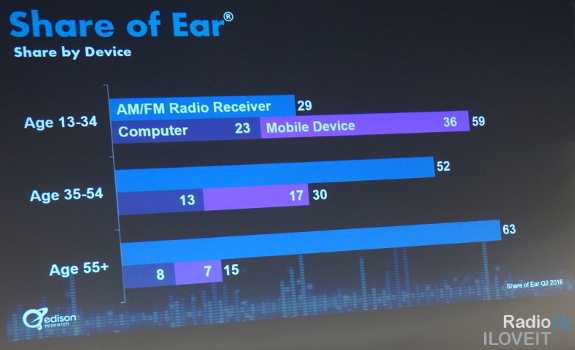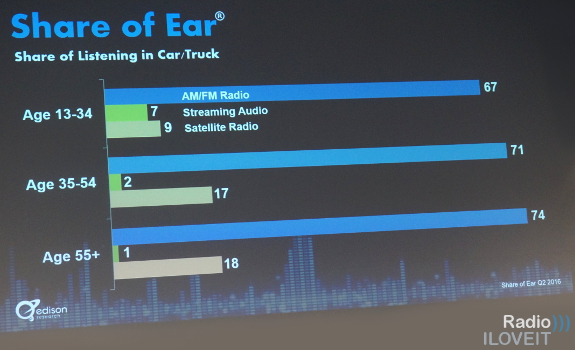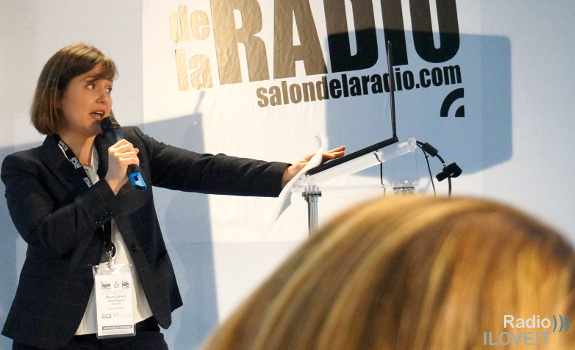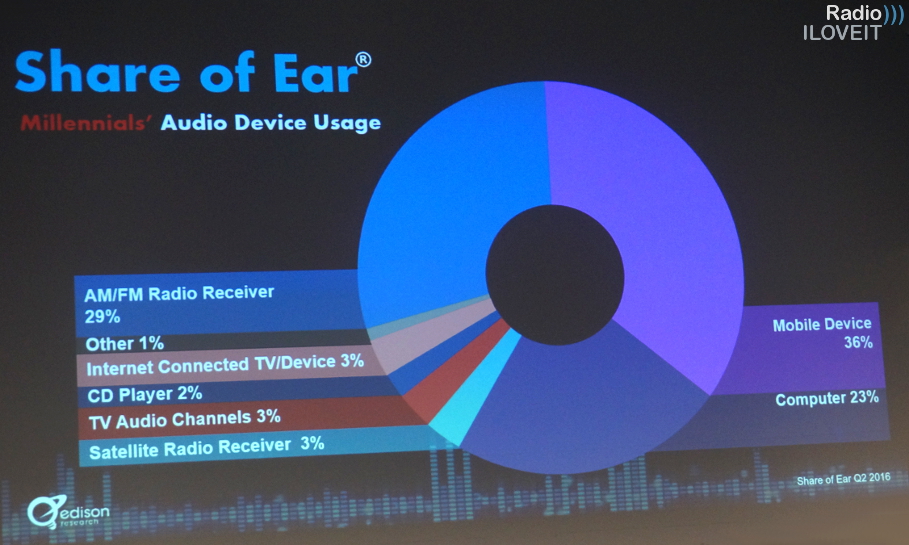Millennials don’t see radio as ‘radio’, they see it as (just one source of) audio. So is there a future for radio stations targeting young listeners?
I think the answer is yes! Le Salon de Radio 2017 in Paris featured a session from which we can learn lessons about how to reach millennials with radio, based on data about how these 13-34 year-olds (born between 1984 and 2004, or you could also say between 1980 and 2000) are consuming audio. The presented facts are based on research in the US, but might be relevant for stations targeting millennials in other markets as well. So, here we go!
Even the gap between millennials and middle-aged is huge

13-34 year-olds are using traditional radio receivers 23% less than 35-54’s (image: Thomas Giger)
Leverage your current reach
Megan Lazovick of Edison Media Research showed interesting findings based on online & offline interviews with “over 8.000 people” who kept an audio diary for one day, recording at which time and on which location, as well as on which platform and through which device they were listening. Their Share of Ear research report (data from the second quarter of 2016) shows that the average American of 13 years and older is listening to about 4 hours of audio a day, divided over several platforms & devices. It’s good to know that radio is still a significant medium, as broadcast radio still gets the big chunk of listening (54%). Music collections are second with 16% (far away from radio), closely followed by streaming audio (15%), like Spotify and Pandora. Satellite radio (7%), music television (5%), and podcast audio (2%) play a relatively small role. That is: for a 13+ audience.
Power your online presence
Splitting these numbers into 3 demos will give us a really different picture. It’s not surprising that the younger people are, the less they’re listening to broadcast radio and the more they’re listening to streaming audio. But the huge gap between 13-34 year-olds on one side, and especially 55+ (but also 35-54) on the other side, makes us realise how fast the online trend is going. Broadcast radio is still the biggest source of listening among 13-34 year-olds (37%), but streaming audio is pretty close (26%; 2/3rd of the size of broadcast) and growing fast. Its share is 5% for 55+, and 13% for 35-54, but again: 26% for 13-34, while AM/FM radio’s size has declined from 67% (55+) to 58% (35-54) to 37% (12-34). Podcast audio is slightly more popular among millennials (5%) than among the overall 13+ demo, which indicates that downloadable audio is likely to have an even more significant share in the future.
Build your mobile position
Listening devices are showing an interesting development. In 13+, which includes a large share of middle-aged and older people, AM/FM receivers are still big. 47% of the population is using AM/FM tuners, 21% is using mobile devices, and 15% is using computers to listen. That picture is, as you would expect, completely different for millennials: 36% of this 13-34 group is using mobile devices, while only 29% of them is using AM/FM receivers. So you want to have a great app, and get it on young people’s smartphones a.s.a.p. Even the gap between millennials and (also smartphone savvy) middle-aged people is huge when it comes to audio consumption across different devices. Comparing these two demographics only; leaving 55+ out of the equation, we see that the use of AM/FM tuners is declining under younger audiences: while 52% of 35-54’s is still using radio receivers, only 29% of 13-34’s are doing that (a difference of 23%). At the same time, millennials are using twice as much mobile & computer devices than middle-aged consumers (59% versus 30%).
Have great morning & drive time shows, and promote them well

Millennials are currently still hearing a lot of broadcast radio in the car (image: Thomas Giger)
Make your brand matter
Lazovick has interviewed people from the millennial generation in their homes, and therefore had a chance to follow their media behaviour all day long. She plays some interview footage, using Blurred Lines as a soundtrack that says it all. Because for today’s 13-34 year-olds, radio isn’t a station coming out of a receiver. Instead, they’re using mobile devices to access many kinds of audio; anything from Spotify to podcasts to radio. That makes it essential to create a great brand that young people love: “The brand is important. It’s important to us to talk about all the different platforms, but we’ve got to remember that they don’t necessarily see that.”
Push your streaming services
American millennials are listening to audio mostly at home (53%), followed by listening in their car (27%), at work (12%) and at other locations (8%). The low numbers for at-work listening could, of course, be partly caused by the fact that the younger half of this 13-34 year-old group is attending a school or university on weekdays. At home, millennials are mostly listening to streaming audio (36%), followed by broadcast radio (23%). So you might want to invest in high-quality audio streams, and make them top of mind when your station is targeting millennials (or wants to attract younger listeners in general). For middle-aged and older audiences, it’s the exact opposite: the older they are, the more they listen to broadcast radio, and the less they listen to streaming audio.
Serve your in-car audience
The great news for AM/FM radio is that 13-34’s are listening a lot to it in the car! As much as 67% of millennials is listening to broadcast radio in their vehicle, which is way ahead of both satellite radio (9%) and streaming audio (7%). The score for millennial in-car radio listening is close to that for 35-54 (71%) and 55+ (74%). Satellite radio is another story, with a huge difference between millennials versus middle-aged and older audiences, who listen to it twice as much (17% and 18%). Young people may have less luxurious cars, or may be less able to afford (or less interested in) a subscription. Maybe because they’re streaming audio in their car significantly more (7%) than the other groups (2% and 1%). Today’s in-car listening figures for AM/FM radio among all demographics are a great opportunity to bring young people in contact with your brand during car-listening peak hours. One more reason to have great morning & drive time shows (including useful service for drivers), and to promote them well.
“We all know what’s going to happen”

Megan Lazovick of Edison Media Research predicts a gradual shift from radio tuners to cell phones, from AM/FM to streaming, and from on-air to on demand (image: Thomas Giger)
Podcast your top content
When talking about which content American millennials like to hear, they found that (not surprising) 86% of their listening is music-related, as opposed to just 14% for speech-based content (7% talk & personality, 5% news, and 2% sports). While the numbers for middle-aged and older people confirm that the older people are, the more they listen to speech, it is evident that music also gets the most time spent listening among these demos (80% for 35-54, and 71% for 55+). Zooming in on speech content, millennials are listening to podcasts for 28% of their audio time, as opposed to only 7% for 35-54 and as little as 3% for 55+. When you’re targeting young radio listeners, you might want to have a podcast connected to your main brand as well as to your sub brands (such as individual personalities & shows belonging to your station), apart from visualising and redistributing your best on-air content on your website and social media,
Reinvent your classic model
Apart from AM/FM’s strong in-car listening position, even among millennials (as long as audio streaming is complicated in the car), it’s realistic to say that we need to evolve broadcast radio as millennials will have a greater and greater impact on audio listening figures. Even if terrestrial radio is still good for 54% of all audio usage (among the entire 13+ universe), 13-34’s are eating only 24% of the broadcast radio pie, while middle-aged and older people both score 38% each (76% in total). But millennials now already own 50% of all music collection listening, 60% of all streaming audio consumption, and as much as 64% of all podcast listening. Regarding where we are heading over the next years, Megan Lazovick thinks that “the answer is obvious; we all know what’s going to happen”. She illustrates her point with a Jetsons video. That cartoon family predicated years ago how we would be living in the future, and so far they got a lot of it right!
Header image: Thomas Giger






Thank you for your good comment! I’ll forward it to Mike, so you guys can talk via email.
(In reply to Mike’s comment)
Hey Mike,
I think you should start incorporating digital inside your radio advertising package. Branded content is the key for radio to stay alive in the future. We can no longer focus on “traditional” ways of selling. Plus, you have to be a great storyteller.
Let’s say your client is a car dealership that needs more people with bad credit to come to the dealership. You know that one of your radio personalities has a bad credit, so you create a 6-week plan on how you are going to create buzz around your client’s dealership.
The first two weeks, you can do a radio promotion revolving around the announcer, or a ‘Bad Credit, Forget It’ promotion where Caller 9 will get a loan paid off, or where the station will pay his downpayment since it’s so high due to bad credit.
During this first week, your morning show has a man on the street, finding out bad credit stories, which will be posted on the radio station’s social media on Monday, Wednesday & Friday. You can guarantee the reach of the post if you understand how Facebook Ads works.
We haven’t even discussed radio ad inventory. This is just your digital sales and your promotional inventory… I can go in full detail on what to do next, but you see what I’m saying.
You can’t go in with numbers anymore; you must sell the whole story, and be a great storyteller. Once you understand branded content you will win in those meetings.
PS – I came up with this while I was typing, so it might not fully thought out, but you can see where I’m going with this. If you ever want to bounce ideas off each other, let me know.
Thomas, my agency has produced radio for a long time. Today, I’m meeting resistance among advertisers re. reaching millennials. Clients are convinced that radio is old; digital is new; young people absolutely do not listen to terrestrial radio.
Nielsen and other research firms say otherwise. When I tell clients this, they stop talking until I finish, then repeat what they said at the beginning – “Millennials are resistant to ‘traditional media’; they don’t like to be sold to, and are not receptive to ‘traditional commercials’.
I do not know how to break this cycle. What do you advise?
Thanks!